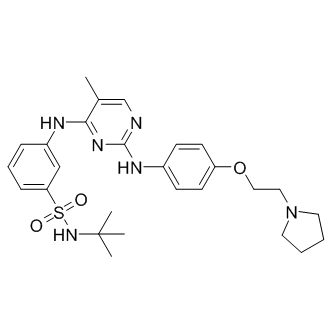| In Vivo: |
Fedratinib (TG-101348) has potential for efficacious treatment of JAK2V617F-associated myeloproliferative diseases (MPD). In treated animals, there is a statistically significant reduction in hematocrit and leukocyte count, a dose-dependent reduction/elimination of extramedullary hematopoiesis, and, at least in some instances, evidence for attenuation of myelofibrosis, correlated with surrogate endpoints, including reduction/elimination of JAK2V617F disease burden, suppression of endogenous erythroid colony formation, and in vivo inhibition of JAK-STAT signal transduction. There are no apparent toxicities and no effect on T cell number[1]. Oral administration of Fedratinib (TG-101348) (120 mg/kg) significantly inhibits PV progenitor erythroid differentiation in vivo[2]. |
| In Vitro: |
Fedratinib (TG-101348) significantly inhibits JAK2 V617F, Flt3, and Ret with IC50 of 3 nM, 15 nM, and 48 nM, respectively. TG101348 has an IC50 appr 300-fold higher for the closely related JAK3 and is a less potent inhibitor of the JAK1 and TYK2 family members. Fedratinib (TG-101348) inhibits proliferation of a human erythroblast leukemia (HEL) cell line that harbors the JAK2V617F mutation, as well as a murine pro-B cell line expressing human JAK2V617F (Ba/F3 JAK2V617F), with IC50 of 305 nM and 270 nM, respectively. Fedratinib (TG-101348) also inhibits proliferation of parental Ba/F3 cells to a comparable level, with IC50 of appr 420 nM. Fedratinib (TG-101348) treatment reduces STAT5 phosphorylation at concentrations that parallel the concentrations required to inhibit cell proliferation. Fedratinib (TG-101348) induces apoptosis in both HEL and Ba/F3 JAK2V617F cells in a dose-dependent manner. Fedratinib does not show proapoptotic activity in control normal human dermal fibroblasts at concentrations up to 10 μM, and the antiproliferative IC50 against fibroblasts is >5 μM[1]. Fedratinib (TG-101348) treatment decreases GATA-1 expression, which is associated with erythroid-skewing of JAK2V617F+ progenitor differentiation, and inhibits STAT5 as well as GATA S310 phosphorylation[2]. Fedratinib (TG-101348) inhibits the proliferation of HMC-1.1 (KITV560G) cells, with somewhat lower potency than HMC-1.2 (KITD816V, KITV560G) cells, with IC50 of 740 nM and 407 nM, respectively[3]. |






















